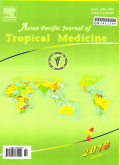- 钛学术文献服务平台 \
- 学术期刊 \
- 医药卫生期刊 \
- 预防医学与卫生学期刊 \
- 亚太热带医药杂志(英文版)期刊 \
Isolation of Kytococcus schroeteri from the brown rat Rattus norvegicus
Isolation of Kytococcus schroeteri from the brown rat Rattus norvegicus
基本信息来源于合作网站,原文需代理用户跳转至来源网站获取
摘要:
Rodents such as Rattus rattus and Rattus norvegicus have adapted to living close to human settlements[1]. This presents a public health challenge as these rodents are considered as pests that can transmit a number of zoonotic diseases to humans[1,2]. A rodent surveillance programme was initiated between the years 2014 and 2015, focusing on rodents captured at wet markets where there is abundant food and considerable human traffic.

推荐文章
大鼠(Rattus norvegicus domestica)八种器官的蛋白质图谱分析
大鼠
器官
聚丙烯酰胺凝胶电泳
蛋白质图谱
Lithium elemental and isotopic disequilibrium in minerals from peridotite xenoliths from Shangzhi, N
Mantle peridotite
Li isotope
Mantle metasomatism
Northeastern China
POD算法在飞机RAT舱温度预测中的应用研究
本征正交分解
冲压空气涡轮舱
温度预测
模态分析
民用飞机RAT发电机自然结冰环境飞行试验研究
民用飞机
RAT发电机
自然结冰
飞行试验
内容分析
关键词云
关键词热度
相关文献总数
(/次)
(/年)
文献信息
| 篇名 | Isolation of Kytococcus schroeteri from the brown rat Rattus norvegicus | ||
| 来源期刊 | 亚太热带医药杂志(英文版) | 学科 | |
| 关键词 | |||
| 年,卷(期) | 2021,(4) | 所属期刊栏目 | Letter to Editor |
| 研究方向 | 页码范围 | 191-192 | |
| 页数 | 2页 | 分类号 | |
| 字数 | 语种 | 英文 | |
| DOI | 10.4103/1995-7645.312515 | ||
五维指标
引文网络
引文网络
二级参考文献 (0)
共引文献 (0)
参考文献 (5)
节点文献
引证文献 (0)
同被引文献 (0)
二级引证文献 (0)
2002(1)
- 参考文献(1)
- 二级参考文献(0)
2005(1)
- 参考文献(1)
- 二级参考文献(0)
2012(1)
- 参考文献(1)
- 二级参考文献(0)
2013(1)
- 参考文献(1)
- 二级参考文献(0)
2018(1)
- 参考文献(1)
- 二级参考文献(0)
2021(0)
- 参考文献(0)
- 二级参考文献(0)
- 引证文献(0)
- 二级引证文献(0)
引文网络交叉学科
相关学者/机构
期刊影响力
亚太热带医药杂志(英文版)
主办单位:
海南医学院杂志社
出版周期:
月刊
ISSN:
1995-7645
CN:
开本:
16开
出版地:
海南省海口市学院路3号
邮发代号:
创刊时间:
2008
语种:
eng
出版文献量(篇)
1905
总下载数(次)
0
总被引数(次)
3966
期刊文献
相关文献
推荐文献
- 期刊分类
- 期刊(年)
- 期刊(期)
- 期刊推荐
亚太热带医药杂志(英文版)2022
亚太热带医药杂志(英文版)2021
亚太热带医药杂志(英文版)2020
亚太热带医药杂志(英文版)2019
亚太热带医药杂志(英文版)2018
亚太热带医药杂志(英文版)2017
亚太热带医药杂志(英文版)2016
亚太热带医药杂志(英文版)2015
亚太热带医药杂志(英文版)2014
亚太热带医药杂志(英文版)2013
亚太热带医药杂志(英文版)2012
亚太热带医药杂志(英文版)2011
亚太热带医药杂志(英文版)2010
亚太热带医药杂志(英文版)2009
亚太热带医药杂志(英文版)2008
亚太热带医药杂志(英文版)2021年第9期
亚太热带医药杂志(英文版)2021年第8期
亚太热带医药杂志(英文版)2021年第7期
亚太热带医药杂志(英文版)2021年第6期
亚太热带医药杂志(英文版)2021年第5期
亚太热带医药杂志(英文版)2021年第4期
亚太热带医药杂志(英文版)2021年第3期
亚太热带医药杂志(英文版)2021年第2期
亚太热带医药杂志(英文版)2021年第10期
亚太热带医药杂志(英文版)2021年第1期

 免费查重
免费查重










